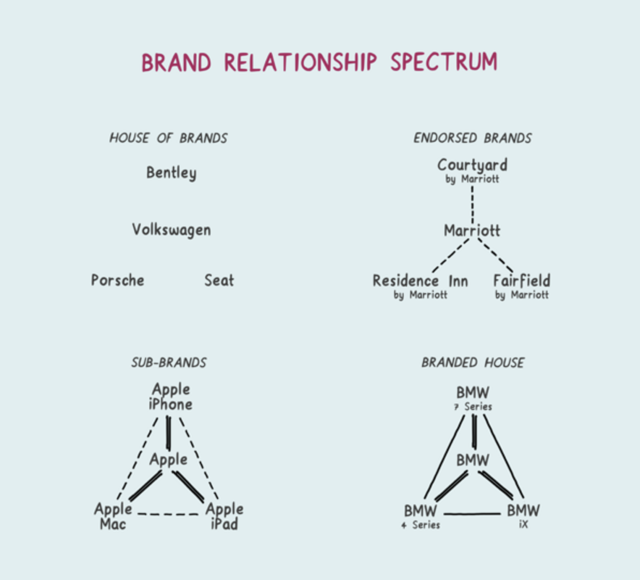Corporate growth often depends on a company building or buying multiple brands. These may exist within one or several product categories. Such a strategy can provide economies of scale. It also reduces risk. If one brand is struggling to grow, profits can be diverted to brands or categories with greater growth potential.
Volkswagen Group, for example, owns many car brands. These include Skoda, SEAT, Volkswagen, Audi, Porsche, Lamborghini and Bentley. This allows Volkswagen to dominate the car industry. It uses different brands to appeal to consumers with different priorities and budgets. At the same time, it saves money by sharing new technologies across the group. It also uses sub-brands to cater for people at different life stages, looking for cars of different sizes (Up!, Golf, Passat, Sharan etc.). By doing this, Volkswagen can tailor its messages and media choices for each sub-brand so that it reaches and influences each target audience.
Yet managing a portfolio of brands represents a major marketing challenge. An architect decides how to connect different spaces. Likewise, a brand manager must define the architecture that will benefit their company. Then they need to build it. The human mind makes connections based on what it experiences. Names, logos, packaging styles, and owned and paid media all influence brand connections. Marketers manage all these touchpoints to construct the desired brand architecture.
In 2000, David Aaker and Erich Joachimsthaler introduced the Brand Relationship Spectrum. It describes the various ways brands and sub-brands can be connected. Aaker and Joachimsthaler identified four approaches. Organizations use one approach or a mixture of approaches and tend to evolve their naming strategies over time.

House Of Brands
A house of brands is a model in which the organization (or ‘house’) keeps its brands entirely separate. A few consumers and people working within the industry may be aware that the brands have the same owner, but the connection is largely irrelevant from a branding point of view. Volkswagen Group, for example, doesn’t publicize that it owns luxury brands Bentley and Porsche as well as budget brands Škoda and Seat. Building an association between these brands would not be desirable. It could even be detrimental. After all, prestige and low price do not sit well together. Linking brands with their parent company can, however, be worthwhile on occasion. When Volkswagen acquired Škoda and improved its cars in 2000, it connected the brand with the Volkswagen name because that carried stronger perceptions of quality.
Endorsed Brands
Endorsed brands are brands that have their own identity but are connected with a familiar, respected parent brand. The strength of the parent helps to make the endorsed brand more credible and appealing. A new fragrance called Obsession could easily be dismissed. Consumers are more likely to pay attention to a new brand called Obsession by Calvin Klein.
This ‘halo effect’ (see below) can work the other way around too. Unilever has often devoted a second or two at the end of its brands’ TV ads to mentioning the corporation’s name. The idea is to make potential investors aware of all the famous household brands Unilever owns. The approach also lends credibility to new Unilever brands when they launch.
Sub-Brands
Many brands adopt a sub-brand strategy. This is like the endorsed brands approach, but the sub-brands’ names include the master brand. This strengthens the link between master and sub-brand. It also strengthens the connection between the sub-brands. A positive experience with one sub-brand generates interest in affiliated sub-brands. Apple has created an ecosystem that enhances the user experience if people buy into the whole range. This strategy also allows sub-brands to develop associations uniquely relevant to their areas, while benefiting from the broader associations of the master brand.
The relative levels of importance of the master brand and the sub-brand vary and can change over time. For example, Sony PlayStation’s early success was boosted by the familiarity and reputation of the Sony name. Over time, the PlayStation name has become more salient and respected in its own right.
Branded House
In a branded house, the master brand name is all-important. The brand’s different product ranges have their own signifiers, but they are not intended to have different identities. All products share the properties and values of the master brand. The branded house approach is the purest approach from a branding point of view. Advertising for the master brand has a positive effect on the whole product range. Advertising for an individual brand also affects the sales of others. This is known as an advertising ‘halo effect.’
Unilever pioneered the use of halos in the 1990s with its personal care brand Dove. It found that the effects were strongest between product areas with a lot in common. For example, sales of Dove’s cleansing bar increased when Dove’s shampoo was advertised. The benefit was greatest when consistent aesthetics and communication themes were used. Dove uses master brand advertising to build memorability and emotional affinity. Alongside this, the brand advertises specific ranges. The range advertising focuses principally on product benefits. All Dove products have skincare properties; this is always part of the communication.
Aaker and Joachimsthaler suggest that the branded house should be the default architecture. Alternatives should be considered by answering these four questions:
- Does the master brand contribute to the offering?
- Will the master brand be strengthened by association with the new offering?
- Is there a compelling need for a separate brand?
- Will the business support a new brand name?
Companies that manage multiple brands may adopt a combination of the brand architecture approaches described above. Apple, for example, uses the house of brands approach for Beats and Mobeewave; the endorsed brands approach for iPhone, iPad, iPod and iMac; and the branded house model for Apple Watch, Apple Music (formerly Apple iTunes) and Apple TV.
Brand managers need to think about where synergies exist to determine where and how to connect their portfolio. Once a clear brand architecture exists, it should be used to guide naming decisions, media strategy and messaging.
Contributed to Branding Strategy Insider by: Dan White, author of The Soft Skills Book, The Smart Marketing Book and The Smart Branding Book
The Blake Project helps organizations transform complex brand architecture problems into marketplace advantages. Please email us to learn how we can help you compete differently.
Branding Strategy Insider is a service of The Blake Project: A strategic brand consultancy specializing in Brand Research, Brand Strategy, Brand Growth and Brand Education




